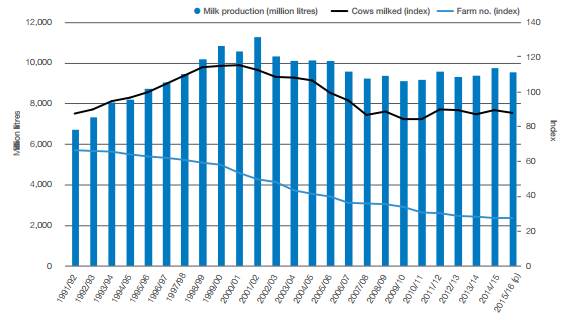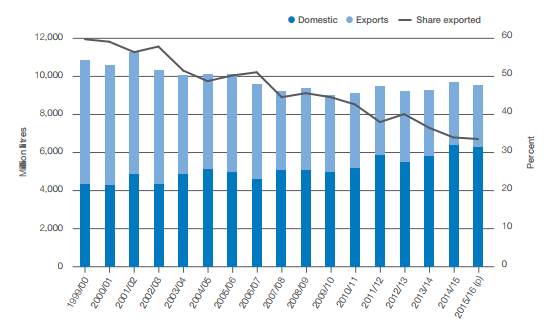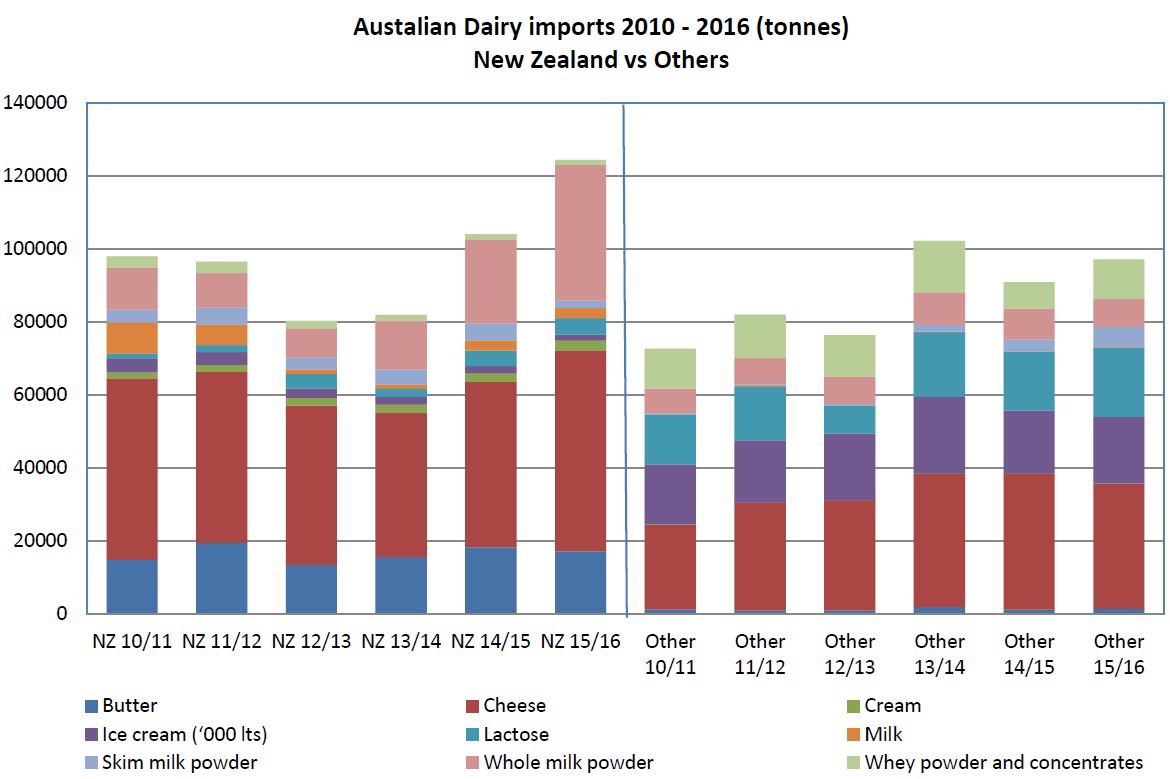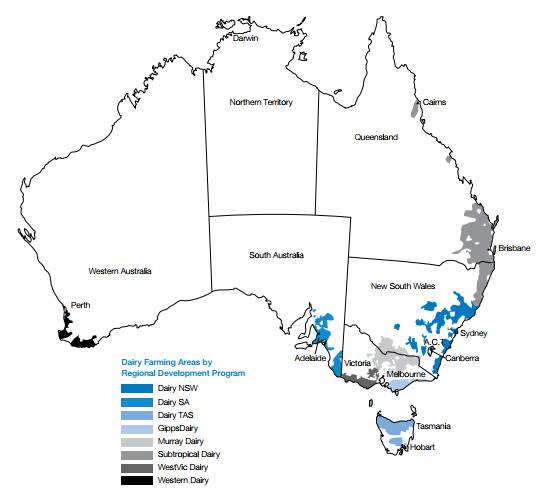Challenges facing the dairy industry
2.1
Despite being Australia's third largest agricultural industry, the dairy
industry faces a number of significant challenges which, if left unaddressed,
have the potential to threaten the long term viability of dairy production. The
industry is not homogenous and varies with distinct challenges across different
geographical regions. Challenges also arise due to the inherent and
interconnected relationships between farmers and end consumers. For many
farmers, the challenges they were already facing were exacerbated by the retrospective
price step‑downs of May 2016.
2.2
A perennial question voiced by stakeholders is why hasn't the Australian
dairy industry grown like its counterpart in New Zealand. A comparison of the two
industry structures is briefly undertaken in this chapter.
Overview of Australia's dairy industry
2.3
The dairy industry in Australia is a $13.7 billion farm, manufacturing
and export industry.[1]
With a farm gate value alone of $4.5 billion, the Australian dairy industry is
Australia's third largest agricultural industry behind beef and wheat.
2.4
Australia's dairy industry consists of around 6000 dairy farms which
produce approximately 9.5 billion litres of milk a year. The industry is
estimated to directly employ approximately 39 000 people on farms and in
factories, while more than 100 000 Australians rely on dairy for their
livelihoods, including vets, scientists, mechanics, financial advisers and feed
suppliers. Approximately 98 per cent of dairy farms are family-owned
businesses.[2]
Increased productivity and farm
debt
2.5
Since deregulation of the industry in 2000, production has remained
relatively stable as herd sizes increased while the number of farms decreased.
The average herd size has increased from 168 head per farm in June 2000 to 273
head per farm in June 2016, while the number of farms halved from almost
13 000 to just over 6000 in the same period (Figure 2.1).[3]
Productivity increases, arising from more efficient practices and the closure
of farms in less productive regions, have resulted in relatively stable
production volumes for the industry overall.
2.6
While Australian dairy farmers' productivity has consistently improved
since deregulation, the price they receive at the farm gate is generally much
less than their international counterparts, particularly northern hemisphere
farmers who are subsidised. That said, their return, on average, has been
higher that New Zealand farmers.
2.7
Murray Goulburn noted that the structural adjustment which increased
productivity was associated with industry deregulation:
The removal of incentives for over-production in 2000
encouraged dairy farms to become more productive (to ensure viability in the
absence of government assistance). In some cases, the land, capital and labour
previously used in dairy farming was reallocated to more productive uses. These
developments have led to fewer, but larger and more productive, dairy farms in
Australia.[4]
Figure
2.1: Australian milk production versus indices of farms and cows milked

Source:
Dairy Australia, Australian Dairy Industry In Focus 2016, p. 13.
2.8
Average farm debt has also increased from $346 000 in 2000 to
$861 500 in 2015 in real terms, reflecting increased farm size and the
exit of smaller farms. Greater levels of borrowing have made many farmers more
vulnerable to exceptional circumstances, such as drought and floods, and variations
in farm gate milk prices.
Increased domestic demand
2.9
Domestic demand for dairy products remains strong with population growth
and per capita milk consumption both contributing to increased dairy
consumption. Dairy Australia notes that 'in 2015–16, 25 per cent of Australia's
milk production was used for drinking milk compared to 18 per cent in 2001–02'.[5]
2.10
As a result, the share of dairy production devoted to export markets has
decreased from 56 per cent in June 2000 to 34 per cent in June 2016 (Figure 2.2).
Figure 2.2: Australian milk consumption and exports
(milk equivalents)

Source:
Dairy Australia, Australian Dairy Industry In Focus 2016, p. 19.
2.11
However, international prices for dairy commodities influence farm gate
milk prices as import barriers to the Australian market are low:
Australian dairy manufacturers will generally not sell into
the domestic market at a lower price than can be obtained in export markets,
and competition amongst domestic manufacturers and from imports (noting import
barriers such as tariffs are low) will ensure that domestic consumers do not
pay more than the world price (notwithstanding there will be some divergence in
prices due to quality differences).[6]
2.12
This view was shared by Murray Goulburn which noted that:
The domestic Australian market is also exceptionally competitive
with international dairy groups also able access this market via free trade
agreements.[7]
2.13
Australia is a significant importer of dairy products, particularly
cheese, butter and whole milk powder from New Zealand and cheese, ice-cream and
lactose from other countries (Figure 2.3).[8]
The importation of dairy products increases the competitive pressure on the
domestic production of manufactured products and provides an alternative avenue
for retailers and food processors to source dairy products.
Figure 2.3: Australian dairy imports

Data sources: Dairy Australia, Australian Dairy
Industry In Focus: Volumes 2012–2016.
Recent challenges
2.14
It is fair to say that the Australian dairy industry has faced a number
of challenges both domestically and internationally in the last few years.
2.15
Globally, the dairy industry has been impacted by oversupply arising
from increased production in Europe, the United States and New Zealand, and
constrained demand from Russian trade bans and an economic slowdown in China.
As the world's fourth largest exporter, lower international prices have flowed
through to processor margins and farm gate milk prices.
2.16
Domestically, weather events and increased input costs have provided
challenging conditions for many farmers, resulting in tighter margins, lower
on-farm investment and reduced confidence. According to Dairy Australia:
The increased level of market and margin volatility within
the industry in the last five to six years has served to undermine confidence
in the outlook for many farmers who are seeking reliable returns on which to
build a longer term future.[9]
2.17
These challenges have affected some dairy regions disproportionately,
particularly those farmers in the Southern Milk Region where retrospective
price step‑downs by Murray Goulburn and Fonterra in April and May 2016
significantly reduced incomes in the 2015–16 season.
2.18
Despite the recent challenges faced by the industry, some stakeholders
were positive about the future.[10]
For example, Australian Dairy Farmers submitted:
While the dairy industry has been under intense pressure, we
are also an industry that has the know-how and resilience to overcome adversity
and thrive in the long term.[11]
2.19
The Department of Agriculture and Water Resources expressed similar
sentiments:
Despite the current challenging operating environment for the
sector, industry fundamentals are sound and long-term prospects remain good.
This is evidenced by continuing capital investment aimed at improving on-farm
efficiencies, greater value-adding in the processing sector to take advantage
of increasing export opportunities arising from Australia's free trade
agreements.[12]
2.20
There also appear to be opportunities in the domestic market and, if
recent trends continue, it is likely that domestic dairy consumption may
outstrip domestic supply in the next decade or so. This situation may provide
an impetus for processors and retailers to reconsider how best to meet future
demand in an environment of increasing population and greater per capita dairy
consumption.
Regional differences in production matter
2.21
The dairy industry is one of Australia's leading rural industries in
terms of adding value through downstream processing. Much of this processing
occurs close to farming areas thereby generating economic activity in many regional
towns.[13]
2.22
While there are eight dairy regions in Australia, it is useful to split
these regions into two distinct groups to understand the main differences in
production (Figure 2.4). The Southern Milk Region—comprising Victoria,
Tasmania, South Australia and southern New South Wales—produce the majority of Australia's
milk and production varies by season. The other dairy regions of central and northern
New South Wales, Queensland and Western Australia, predominantly supply fresh
milk to the domestic market and have more stable production profiles to meet
processor requirements.
Figure 2.4: Australia's dairy regions

Source: Dairy Australia, Australian Dairy In Focus
2016, p. 36.
2.23
Although milk is produced in all states, the majority of milk
production is concentrated in the Southern Milk Region. Indeed, Victoria
produces over 60 per cent of all milk by value, has 57 per cent of the dairy
farms and 65 per cent of dairy cattle. Compared to the rest of the country, the
Southern Milk Region is more climatically favourable for dairy farming as it
receives sufficient rainfall for pasture growth which, along with grain,
comprises the critical feed input for dairy farming.[14]
Seasonal differences and variations
in milk production across regions
2.24
Milk output varies with seasonal conditions and is dependent on when
calving takes place. This normally occurs in spring when pasture is most
abundant and is referred to as 'seasonal production'.[15]
The Australian dairy industry is strongly seasonal, which allows it to be
predominantly pasture-based. Approximately 60 to 65 per cent of cattle
feed requirements comes from pasture feed and this results in efficient,
high-quality milk production.[16]
2.25
In the Southern Milk Region where seasonal production is most common,
milk production peaks in October, tapers off until late-Summer, and then
flattens out into the cooler winter months. The production of less perishable
dairy products, such as cheese, milk powders and ice‑cream, in these
areas allows producers and manufacturers to maximise their large production of
raw milk within the seasonal cycle.[17]
2.26
The other production system used is 'year round production', and is
mainly found in Western Australia, Queensland and northern New South Wales.
Year round production is when calving is distributed throughout the year to
achieve a more reliable supply of raw milk. Producing milk to meet the
consistent daily demand throughout the year is challenging, given the normal seasonal
variation in the production cycle. As such, requirements by processors for
farmers to have flat production systems to match fresh milk market profiles adds
to farm cost structures and risks, resulting in higher costs of production.[18]
Relationships with processors are also important
2.27
The Australian dairy processing sector includes farmer‑owned co‑operatives,
public, private and multinational companies. Farmer‑owned co‑operatives
were once dominant in the industry; however, only two remain—Murray Goulburn
and Norco—and process around 40 per cent of milk production.[19]
While Murray Goulburn is the market leader, the next four largest processors
are all foreign‑owned or controlled—Fonterra (New Zealand); Parmalat
(France); Lion Dairy and Drinks (Japan); and Warrnambool Cheese and Butter (Saputo,
Canada). In 2015–16, the five largest processors accounted for 79 per cent of
volume nationally.[20]
2.28
As there has been no growth in milk production over the last decade,
there has been limited investment to increase processing capacity. While some
processors have invested in the development of new product lines, such as
Murray Goulburn's establishment of fresh milk processing capacity in Laverton,
others have closed or sold off production facilities which were not profitable
and/or did not fit with their business objectives.
2.29
Processors make operational and investment decisions about how best to
add value to raw milk which reflect expectations about projected market demand
and existing capacity in other processors. However, these decisions lock
processors into particular product mixes whereby the prices for these products
are subject to market forces. Decisions made by processors on the size of
facilities, scale of operations and asset utilisation rates depend on the
volume and seasonal variability of milk supply. These factors also affect the
cost and competitiveness of dairy processing.[21]
2.30
In addition, market dominance by a small number of large processors has
the potential to reduce options for farmers, particularly as processing
facilities must be located relatively close to farms. Following the retrospective
price step-downs in April and May 2016, for example, many farmers found that
they could not find alternative processors willing to take their milk.
Similarly, a small number of farmers in Western Australia were forced to exit
the dairy industry when none of the three processors in that region were
willing to take them on.
2.31
That said, many processors consider that competition for raw milk is
robust, particularly in the Southern Milk Region. Bega Cheese noted that:
When considering the market environment the Australian dairy
industry operates in, it is notable that it is one of the most competitive in
the world with a wide range of dairy manufacturers competing for both market
share and milk supply.[22]
2.32
Fonterra also noted that the Southern Milk Region is highly competitive,
with processors competing for supply to fill their factories and setting milk
prices at levels similar to that of their competitors.[23]
Interdependencies between
processors and farmers are strong
2.33
The interdependency between processors and farmers are more important in
the dairy industry than most other agricultural industries. Australian Dairy
Farmers noted that:
Collaboration is the key to get use where we need to be. Our
industry relies on all the elements to operate efficiently. Farmers need
processors and vice versa—so the solutions require all stakeholders to come
together to ensure a positive future.[24]
2.34
While there is no doubt that collaboration is important, it does appear
that the interdependencies between processors and farmers, and retailers and
processors, have resulted in power being concentrated in the hands of
processors and retailers. To many stakeholders, addressing the imbalance of
power between retailers, processors and farmers is of central importance to
ensuring the sustainability and viability of the dairy industry in Australia.
For example, WA Farmers commented that:
Due to the very nature of dairy products being fresh and
perishable, farmers are in a perilous situation as the milk they produce must
be collected on a daily basis. As a result, dairy farmers have very limited
market power. Unlike farmers that produce commodities like wheat which can be
stored until more favourable market conditions prevail.[25]
2.35
Similarly, Mr Nigel Hicks submitted that:
...processors and retailers have used market power to impact on
farm gate prices and deliver returns to their shareholders. This is normal
business practice and an obligation of the directors of these companies to do
so. It also highlights that there is money to be made from the dairy industry
but that there is an imbalance in the distribution of the income generated.[26]
2.36
Issues related to power imbalances within the dairy industry and the
effect it has on farm gate milk prices is considered in more detail in chapter
3.
Comparison with the New Zealand dairy industry
2.37
Many parallels have been drawn between the Australian and New Zealand
dairy industries, with some stakeholders questioning why the Australian dairy
industry has effectively stalled over the last decade while output in New
Zealand has almost doubled. Many of these stakeholders have advocated for
Australia to emulate the so-called New Zealand dairy model by creating a
'national champion' dairy product manufacturer.
2.38
The Productivity Commission (PC) examined this issue in detail in the 2014
report, Relative Costs of Doing Business in Australia: Dairy Product
Manufacturing, and concluded:
...it is overly optimistic to attribute New Zealand's dairy
export performance primarily to the formation of Fonterra, let alone to use this
experience to drive policy decisions in Australia. While the formation of
Fonterra may well have assisted—at least in part—New Zealand's recent success
on global dairy market, it is also the case that—relative to Australia—the New
Zealand dairy industry has benefited from a number of significant advantages
over this period including:
-
a free trade agreement with China,
which has provided New Zealand dairy with significantly improved access to the
Chinese market...
-
the absence of drought compared
with Australia, which has experienced severe drought in 2002–03 and 2006–07
-
a lower-valued currency...
-
competition for land, labour and
expertise amongst domestic industries was—more than likely—less intense in New
Zealand than in Australia over recent years. While the resources investment
boom in Australia drew resources away from dairy and toward higher returning
industries, relatively low returns to many non-dairy agricultural industries
(such as sheep and forestry) in New Zealand led to a high rate of land conversion
towards dairying.[27]
2.39
Bega Cheese also provided some useful context on the differences between
the dairy industries in each country:
The Australian dairy industry has evolved differently to the
industry in New Zealand which it is often compared to. While the New Zealand
dairy industry has a very small domestic market and is almost totally exposed
to international markets, the Australian industry is more balanced with a
little less than half of its production destined for international markets and
the remainder being sold in the Australian domestic market. The difference has
seen Australian based companies develop a strong focus on value added retail
and food service products and high value dairy ingredients. The benefit of
these strategies, and a more stable return in the Australian domestic market,
can be seen in generally a stronger price to farmers in Australia when compared
to New Zealand in periods where the global dairy commodity price in relative
terms is low. In times where global commodity prices are high generally the New
Zealand farm gate milk price out performs the Australian price.[28]
2.40
Indeed, Fonterra provided the committee with details of the farm gate
milk price it paid to its farmers in Australia and New Zealand. Table 1
illustrates that the New Zealand farm gate price is much more volatile
depending on global conditions.
Table 1: Fonterra milk price in Australia and New
Zealand since 2010
|
FY10 |
FY11 |
FY12 |
FY13 |
FY14 |
FY15 |
FY16 |
| Australia FMP (A$/kgMS) |
$4.50 |
$5.7 |
$5.45 |
$4.97 |
$6.95 |
$6.00 |
$5.13 |
| New Zealand FMP (NZ$/kgMS) |
$6.10 |
$7.60 |
$6.08 |
$5.84 |
$8.40 |
$4.40 |
$3.90 |
Source: Fonterra Co-operative, Submission 38,
p. 7.
2.41
There is no doubt the New Zealand dairy industry has expanded rapidly
while its Australian counterpart has remained relatively stable by comparison.
This has been assisted by the emergence of a dominant processor, Fonterra,
which has been able to optimise the investment in, and operating of, processing
facilities for a rapidly expanding industry. It has done this in a way that the
fragmented and privatised structure of the industry in Australia has not been
able to follow. Whereas productive land in New Zealand has been drawn into
dairy industry, many Australian dairy farms have been converted for other applications,
reflecting opportunities to use this land for more productive purposes. As a
result, it is not appropriate to make simple comparisons between the dairy
industries of Australia and New Zealand when there are more complex and often
subtle forces that explain the different trajectories between these
jurisdictions.
Navigation: Previous Page | Contents | Next Page